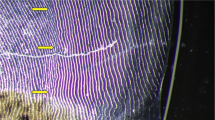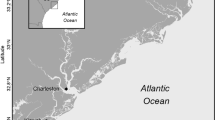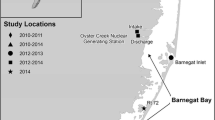Abstract
Our study was designed to examine early life stage tarpon (Megalops atlanticus) recruitment, habitat use, and residency in coastal environments near the northern limit of their distribution in the western Atlantic Ocean. We employed a multi-faceted approach to (1) collect ingressing larval tarpon on nighttime flood tides at multiple sites, (2) document larval and juvenile tarpon use of natural high marsh pools, and (3) examine juvenile tarpon movement and behavior in managed marsh impoundments, all in the North Inlet-Winyah Bay estuarine system of South Carolina, USA. The timing of recruitment (June through November) and size of larvae (mean ± standard deviation = 23 ± 3 mm standard length [SL]) during estuarine ingress was similar to that reported from other subtropical locations in the region. Soon after recruiting into the system, larval and small juvenile tarpon (47 ± 25 mm SL) co-occurred in high marsh pools from July to November, and large juveniles (201 ± 34 mm SL) were also present in marsh impoundments during this same time period. An increase in tarpon length over time during their residency in high marsh pools and the relatively large size they attain in marsh impoundments indicate these environments may function as favorable nursery habitats. As water temperatures decreased during October and November, juvenile tarpon emigrated from these estuarine habitats. Tarpon appear to use a variety of estuarine habitats in coastal South Carolina from summer through late fall during their early life stage development. The fate of these individuals after they leave estuarine habitats at the onset of winter in this region is currently unknown.








Similar content being viewed by others
References
Allen, D.M., and D.L. Barker. 1990. Interannual variations in larval fish recruitment to estuarine epibenthic habitats. Marine Ecology Progress Series 63: 113–125.
Allen, D.M., V. Ogburn-Matthews, and P.D. Kenny. 2017. Nekton use of flooded salt marsh and an assessment of intertidal creek pools as low-tide refuges. Estuaries and Coasts 40: 1450–1463.
Allen, D.M., S.S. Haertel-Borer, B.J. Milan, D. Bushek, and R.F. Dame. 2007. Geomorphological determinants of nekton use of intertidal salt marsh creeks. Marine Ecology Progress Series 329: 57–71.
Allen, D.M., W.B. Allen, R.F. Feller, and J.S. Plunket, eds. 2014. Site profile of the North Inlet–Winyah Bay National Estuarine Research Reserve, 432 pp. Georgetown, SC: North Inlet–Winyah Bay National Estuarine Research Reserve.
Ault, J.S., R. Humston, M.F. Larkin, E. Perusquia, N.A. Farmer, J. Luo, N. Zurcher, S.G. Smith, L.R. Barbieri, and J.M. Posada. 2008. Population dynamics and resource ecology of Atlantic tarpon and bonefish. In Biology and management of the world tarpon and bonefish fisheries, ed. J.S. Ault, 217–258. Boca Raton, FL: CRC Press.
Beebe, W. 1927. A tarpon nursery in Haiti. Bulletin of the New York Zoological Society 30: 141–145.
Bozeman, E.L., Jr., and J.M. Dean. 1980. The abundance of estuarine larval and juvenile fish in a South Carolina intertidal creek. Estuaries 3: 89–97.
Breder, C.M., Jr. 1944. Materials for the study of the life history of Tarpon atlanticus. Zoologica 29: 217–252.
Cain, R.L., and J.M. Dean. 1976. Annual occurrence, abundance and diversity of fish in a South Carolina intertidal creek. Marine Biology 36: 369–379.
Chacón, D. 1994. Ecología básica y alimentación del sábalo Megalops atlanticus (Pisces: Megalopidae). Revista de Biología Tropical 42: 225–232.
Chacón, D., and W.O. McLarney. 1992. Desarrollo temprano del sábalo, Megalops atlanticus (Pisces: Megalopidae). Revista de Biología Tropical 40: 171–177.
Crabtree, R.E. 1995. Relationship between lunar phase and spawning activity of tarpon, Megalops atlanticus, with notes on the distribution of larvae. Bulletin of Marine Science 56: 895–899.
Crabtree, R.E., E.C. Cyr, R.E. Bishop, L.M. Falkenstein, and J.M. Dean. 1992. Age and growth of tarpon, Megalops atlanticus, larvae in the eastern Gulf of Mexico, with notes on relative abundance and probable spawning areas. Environmental Biology of Fishes 35: 361–370.
Cyr, E.C. 1991. Aspects of the life history of the tarpon, Megalops atlanticus, from south Florida, 138 pp. Columbia, SC: Ph.D. Dissertation. University of South Carolina.
Franks, J. S., D. P. Gibson, J. D. Tilley, P. M. Graham, P. O. Grammer, and S. S. Curran. 2013. Investigations of tarpon (Megalops atlanticus) in Mississippi coastal waters. Final Report to Mississippi Department of Marine Resources. 43 pp.
Gilmore, R.G., D.W. Cooke, and C.J. Donohoe. 1982. A comparison of the fish populations and habitat in open and closed salt marsh impoundments in east-central Florida. Northeast Gulf Science 5: 25–37.
Harrington, R.W., Jr. 1966. Changes through one year in the growth rates of tarpon, Megalops atlanticus Valenciennes, reared from mid-metamorphosis. Bulletin of Marine Science 16: 863–883.
Harrington, R.W., Jr., and E.S. Harrington. 1960. Food of larval and young tarpon, Megalops altantica. Copeia 1960: 311–319.
Hettler, W.F., Jr., and A.J. Chester. 1990. Temporal distribution of ichthyoplankton near Beaufort Inlet, North Carolina. Marine Ecology Progress Series 68: 157–168.
Hildebrand, S.F. 1934. The capture of a young tarpon, Tarpon atlanticus, at Beaufort, North Carolina. Copeia 1934: 45–46.
Jud, Z.R., C.A. Layman, and J.M. Shenker. 2011. Diet of age-0 tarpon (Megalops atlanticus) in anthropogenically-modified and natural nursery habitats along the Indian River Lagoon, Florida. Environmental Biology of Fishes 90: 223–233.
Kimball, M.E., L.P. Rozas, K.M. Boswell, and J.H. Cowan Jr. 2010. Evaluating the effect of slot size and environmental variables on the passage of estuarine nekton through a water control structure. Journal of Experimental Marine Biology and Ecology 395: 181–190.
Kimball, M.E., L.P. Rozas, K.M. Boswell, and J.H. Cowan Jr. 2015. Effects of slotted water control structures on nekton movement within salt marshes. Marine and Coastal Fisheries: Dynamics, Management, and Ecosystem Science 7: 177–189.
Kimball, M.E., K.M. Boswell, and L.P. Rozas. 2017. Estuarine fish behavior around slotted water control structures in a managed salt marsh. Wetlands Ecology and Management 25: 299–312.
Korsman, B.M., M.E. Kimball, and F.J. Hernandez Jr. 2017. Spatial and temporal variability in ichthyoplankton communities ingressing through two adjacent inlets along the southeastern US Atlantic coast. Hydrobiologia 795: 219–237.
Mace, M.M., III, E.R. Haffey, and M.E. Kimball. 2017. Low-temperature tolerance of juvenile tarpon Megalops atlanticus. Environmental Biology of Fishes 100: 913–922.
Marwitz, S.R. 1986. Young tarpon in a roadside ditch near Matagorda Bay in Calhoun County, Texas. Texas Parks and Wildlife Department, Management Data Series Number 100: 1–8.
Mateos-Molina, D., M. Schärer-Umpierre, M. Nemeth, H. Ruiz, I. Ruiz-Valentín, and J. Vargas-Santiago. 2013. Ecology and distribution of tarpons (Megalops atlanticus) at the Boquerón Wildlife Refuge, Puerto Rico. Proceedings of the Gulf and Caribbean Fisheries Institute 65: 262–265.
McGovern, J.C. 1986. Seasonal recruitment of larval and juvenile fishes into impounded and non-impounded marshes, 123 pp. Charleston, SC: M.S. Thesis. College of Charleston.
McGovern, J.C., and C.A. Wenner. 1990. Seasonal recruitment of larval and juvenile fishes into impounded and non-impounded marshes. Wetlands 10: 203–221.
Moffett, A.W., and J.E. Randall. 1957. The Roger Firestone tarpon investigation progress report, 18 pp. FL: University of Miami.
Nichols, K. M. 1994. Age and growth of juvenile tarpon, Megalops atlanticus from Costa Rica, South Carolina and Venezuela. Honors Thesis. University of South Carolina. Columbia, SC. 52 pp.
Poulakis, G.R., J.M. Shenker, and D.S. Taylor. 2002. Habitat use by fishes after tidal reconnection of an impounded estuarine wetland in the Indian River Lagoon, Florida (USA). Wetlands Ecology and Management 10: 51–69.
Reyier, E.A., and J.M. Shenker. 2007. Ichthyoplankton community structure in a shallow subtropical estuary of the Florida Atlantic Coast. Bulletin of Marine Science 80: 267–293.
Rickards, W.L. 1966. A study of the ecology of first-year tarpon, Megalops atlantica Valenciennes, in a Georgia salt-marsh, with laboratory studies of growth rates and ecological growth efficiencies, 67 pp. Athens, GA: M.S. Thesis. University of Georgia.
Rickards, W.L. 1968. Ecology and growth of juvenile tarpon, Megalops atlanticus, in a Georgia salt marsh. Bulletin of Marine Science 18: 220–239.
Robinson, K.F., and C.A. Jennings. 2014a. Productivity of functional guilds of fishes in managed wetlands in coastal South Carolina. Journal of Fish and Wildlife Management 5: 70–86.
Robinson, K.F., and C.A. Jennings. 2014b. A comparison of resident fish assemblages in managed and unmanaged coastal wetlands in North Carolina and South Carolina. Southeastern Naturalist 13: 237–260.
Schwartz, F.J. 2002. Occurences of elopiform fishes of the genera Elops, Megalops, and Albula in North Carolina. Journal of the North Carolina Academy of Science 118: 86–90.
Shenker, J.M., and J.M. Dean. 1979. The utilization of an intertidal salt marsh creek by larval and juvenile fishes: abundance, diversity and temporal variation. Estuaries 2: 154–163.
Shenker, J.M., E. Cowie-Mojica, R.E. Crabtree, H.M. Patterson, C. Stevens, and K. Yakubik. 2002. Recruitment of tarpon (Megalops atlanticus) leptocephali into the Indian River Lagoon, Florida. Contributions in Marine Science 35: 55–69.
Smith, D.G. 1980. Early larvae of the tarpon, Megalops atlantica Valenciennes (Pisces: Elopidae), with notes on spawning in the Gulf of Mexico and the Yucatan Channel. Bulletin of Marine Science 30: 136–141.
Stein, W., III, J.M. Shenker, and M.T. O'Connell. 2016. A contribution to the life history of tarpon (Megalops atlanticus) in the northern Gulf of Mexico. Southeastern Naturalist 15: 496–512.
Stevens, P.W., C.L. Montague, and K.J. Sulak. 2006. Patterns of fish use and piscivore abundance within a reconnected saltmarsh impoundment in the northern Indian River Lagoon, Florida. Wetlands Ecology and Management 14: 147–166.
Taylor, D.S., G.R. Poulakis, S.R. Kupschus, and C.H. Faunce. 1998. Estuarine reconnection of an impounded mangrove salt marsh in the Indian River Lagoon, Florida: short-term changes in fish fauna. Mangroves and Salt Marshes 2: 29–36.
Teal, J.M. 1958. Distribution of fiddler crabs in Georgia salt marshes. Ecology 39: 185–193.
Tucker, J.W., Jr., and R.G. Hodson. 1976. Early and mid-metamorphic larvae of the tarpon, Megalops atlantica, from the Cape Fear River estuary, North Carolina, 1973-74. Chesapeake Science 17: 123–125.
Wade, R.A. 1962. The biology of the tarpon, Megalops atlanticus, and the ox-eye, Megalops cyprinoides, with emphasis on larval development. Bulletin of Marine Science of the Gulf and Caribbean 12: 545–622.
Wade, R.A. 1968. Ecology of juvenile tarpon, with special attention to the effects of dieldrin on two associated species, Cyprinodon variegatus and Poecilia latipinna, 132 pp. Coral Gables, FL: Ph.D. Dissertation. University of Miami.
Weber, L.M., and S.M. Haig. 1996. Shorebird use of South Carolina managed and natural coastal wetlands. The Journal of Wildlife Management 60: 73–82.
Wenner, C. A., J. C. McGovern, R. Martore, H. R. Beatty, and W. A. Roumillat. 1986. Icthyofauna. p. 415–526. In: M. R. Devoe and D. S. Baughman (eds.). South Carolina coastal wetland impoundments: ecological characterization, management, status, and use. Vol. II: Technical Synthesis. Publication No. SC-SG-TR-86-2. South Carolina Sea Grant Consortium, Charleston, SC.
Zale, A. V., and S. G. Merrifield. 1989. Species profiles: life histories and environmental requirements of coastal fishes and invertebrates (South Florida)—ladyfish and tarpon. U.S. Fish Wildl. Serv. Biol. Rep. 82(11.104). U.S. Army Corps of Engineers, TR EL-82-4. 17 pp.
Zerbi, A., C. Aliaume, and J.M. Miller. 1999. A comparison between two tagging techniques with notes on juvenile tarpon ecology in Puerto Rico. Bulletin of Marine Science 64: 9–19.
Zerbi, A., C. Aliaume, and J.-C. Joyeux. 2001. Growth of juvenile tarpon in Puerto Rican estuaries. ICES Journal of Marine Science 58: 87–95.
Zerbi, A., C. Aliaume, J.M. Miller, and J.-C. Joyeux. 2005. Contributions to the ecology of juvenile tarpon Megalops atlanticus in an impoundment in southwestern Puerto Rico. Proceedings of the Gulf and Caribbean Fisheries Institute 47: 478–498.
Acknowledgements
We thank A. Adams and J. Wilson from BTT for their suggestions and guidance with the development and execution of this project. We would also like to thank the faculty, staff, and students from the South Carolina Department of Natural Resources Tom Yawkey Wildlife Center (J. Collington, J. Dozier, H. Evans, B. Gamble, J. Lee, F. Sim, Z. Simpson), USC Baruch Marine Field Laboratory (D. Allen, S. Forehand, M. Kennedy, P. Kenny, T. Thomas), Cornell College Rogers Fellowship in Environmental Studies program (R. Bulger, J. Dean, J. Tesensky), and Wofford College (K. Dickson, D. Kusher, K. Moorhouse) for their assistance with this study. This manuscript was improved by reviews from L. Rozas and two anonymous reviewers.
Author information
Authors and Affiliations
Corresponding author
Ethics declarations
This research was conducted in accordance with the guidelines set forth in University of South Carolina IACUC Animal Care and Use Protocols #2154-100810-040814, #2264-101032-080315, and #2273-101047-093015.
Funding
Funding for this research was provided by the Bonefish & Tarpon Trust (BTT).
Conflict of Interest
The authors declare that they have no conflict of interest.
Additional information
Communicated by Josianne G. Støttrup
Electronic Supplementary Material
ESM 1
(DOCX 59.6 kb)
Rights and permissions
About this article
Cite this article
Mace, M.M., Kimball, M.E. & Haffey, E.R. Recruitment and Habitat Use of Early Life Stage Tarpon (Megalops atlanticus) in South Carolina Estuaries. Estuaries and Coasts 41, 841–854 (2018). https://doi.org/10.1007/s12237-017-0304-4
Received:
Revised:
Accepted:
Published:
Issue Date:
DOI: https://doi.org/10.1007/s12237-017-0304-4




